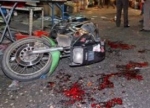
An insurgency is dividing the villages around Pattani by religion.
It is a conflict the government admits it is losing. A harsh crackdown and martial law in recent years seem only to have fueled the insurgency by generating fear and anger and undermining moderate Muslim voices.
A new policy of conciliation in the past four months has been met by increased violence, including a barrage of 28 coordinated bombings in the south that killed or wounded about 60 people on Feb. 18.
“The momentum of violence is now beyond the control of government policy,” said Srisompob Jitpiromsri, a political scientist at Prince of Songkhla University here.
“The separatists can pick and choose the time and place of the violence without any effective resistance from the government,” he said. “They have the upper hand.”
Now the insurgents seem to be taking their war to a new stage, pitting local Buddhists against Muslims by attacking symbols of Buddhism with flamboyant brutality.
The two religions had coexisted through the years here, often in separate villages. That mutual tolerance is breaking down now, and there are fears of a sectarian conflict that could flare out of control.
“Buddhist monks, temples, novices,” said Sunai Phasuk, a political analyst with the monitoring group Human Rights Watch. “Buddhist monks have been hacked to death, clubbed to death, bombed and burned to death. This has never happened before. This is a new aspect of violence in the south.”
In another new development, said Francesca Lawe-Davies, an analyst with the International Crisis Group, some remote areas had become, in effect, off limits for the police or military, at least temporarily and perhaps permanently.
“It appears in the last year or so that insurgent groups are actually starting to control territory in a more conventional sense,” she said.
Some Buddhist and Muslim villages have begun sealing themselves off from one another, and people in both the region’s towns and villages say old friendships and patterns of cooperation are being undermined by mistrust.
Entire Buddhist communities have also fled in a “de facto ethnic cleansing,” said Zachary Abuza, the author of “Militant Islam in Southeast Asia,” in a report published last month. “The social fabric of the south has been irreparably damaged.”
About 1.3 million ethnic Malay Muslims form a majority in Thailand’s three southernmost provinces — Yala, Narathiwat and Pattani — a tiny percentage of the population of 65 million, which is overwhelmingly Buddhist.
The Muslims have complained of discrimination and attempts at forced assimilation since Thailand annexed the former Sultanate of Pattani a century ago. Armed insurgencies have risen and subsided over the past four decades, but the government may now be facing its most dangerous challenge.
“What is new about the current conflict is the level and degree of violence, the Islamist agenda of the insurgents and their unprecedented degree of cooperation and coordination,” Mr. Abuza said.
“The level of violence in Thailand’s south has never been higher,” he said. “Nor has it been more brutal.”
He said in his report that there had been more than 24 beheadings in the past three years and as many as 60 similar attacks.
Human Rights Watch counted more than 6,000 violent episodes over the past three years. It said more than 60 teachers and 10 students had been killed and 110 schools — the most visible signs of central government authority in many places — had been set ablaze.
About half the insurgents’ attacks have been against other Muslims, especially those who cooperate with the government, in what appears to be an effort to weaken central control. The victims include not only village chiefs and suspected collaborators but also those who work in government jobs, teach at government-financed schools or work in major sectors like rubber tapping.
All of this adds up to war, Mr. Srisompob said. The military has flooded the region with up to 20,000 new troops; checkpoints have been set up along the roads; soldiers travel in convoys of armored vehicles.
“In the local communities in the red zones, it already is a war situation,” he said. “It is different now from last year, from the last two years.”





















The comments are closed.